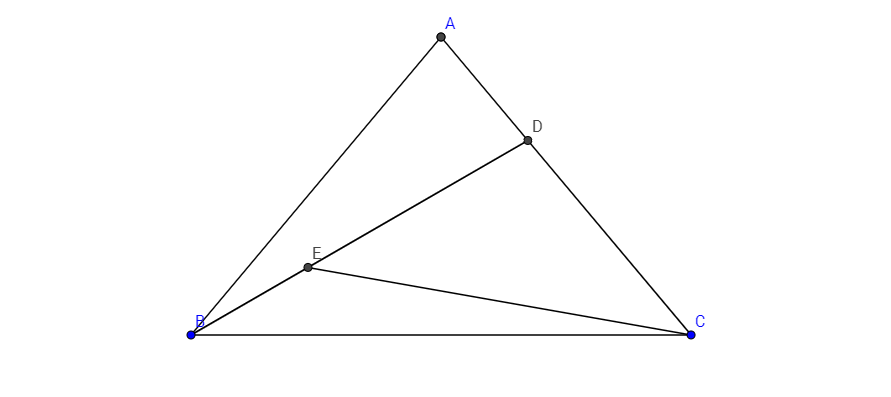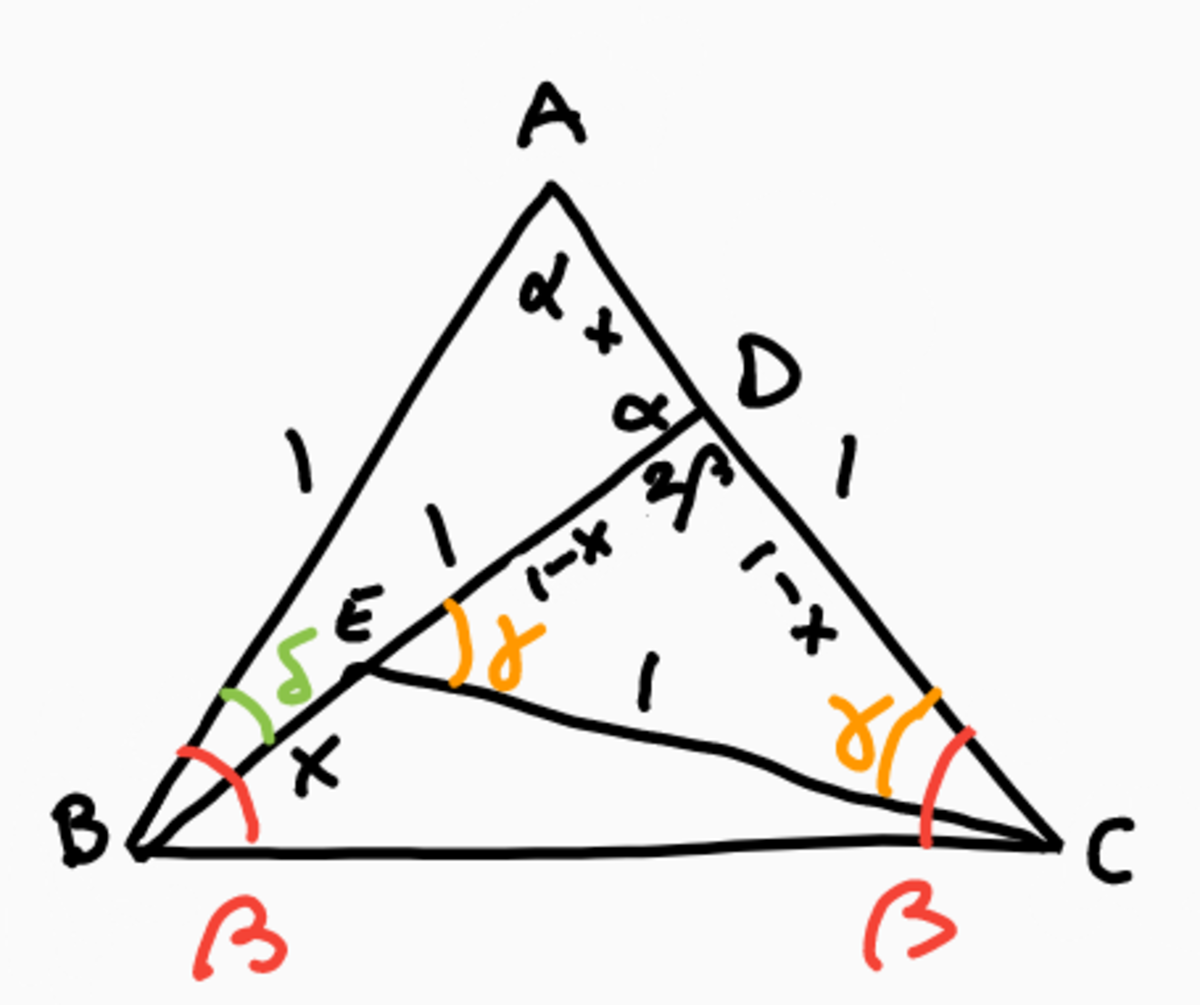Lots of geometrical coincidences
In △ A B C , A B = A C . Now a point D lies on A C so that A B = B D and a point E satisfies A D = B E as well as A C = C E . Interestingly, points B , E and D are collinear. If ∠ A B C = q p π radians where p and q are coprime positive integers, p + q = ?

The answer is 23.
This section requires Javascript.
You are seeing this because something didn't load right. We suggest you, (a) try
refreshing the page, (b) enabling javascript if it is disabled on your browser and,
finally, (c)
loading the
non-javascript version of this page
. We're sorry about the hassle.
3 solutions
For simplicity, take A B = 1 . Also, let ∠ D C E = θ . Since B D = A B = A C and A D = B E , E D = B D − B E = A C − A D = C D , meaning that △ C D E is isosceles. Then, ∠ D E C = θ as well, and by the External Angle Theorem, ∠ B D A = 2 θ .
We use the fact that A D + D C = A C = 1 and write A D and D C in terms of θ to obtain an equation in θ .
Because △ B A D is isosceles, the perpendicular from B bisects A D , so A D = 2 B D cos 2 θ = 2 cos 2 θ . Likewise, since △ D C E is isosceles, the perpendicular from D bisects C E , so D C = cos θ 2 C E = 2 cos θ 1 .
Then, we have that 2 cos θ 1 + 2 cos 2 θ = 1 .
Using the identity cos 2 θ = 2 cos 2 θ − 1 , multiplying both sides by 2 cos θ , simplifying, this becomes 8 cos 3 θ − 6 cos θ + 1 = 0 .
Using the identity cos 3 θ = 4 cos 3 θ − 3 cos θ , we get 2 cos 3 θ + 1 = 0 , so θ = 9 2 π (any larger θ that satisfies the equation causes 2 θ to be greater than 9 0 ° , which doesn't work as the sum of the internal angles of △ B A D is greater than 4 θ ).
Finally, since △ A B C is isosceles with ∠ B A C = θ , ∠ A B C = 2 π − θ = 1 8 5 π , so our answer is 5 + 1 8 = 2 3 .

We have some isoscelese triangles:
- because A B = A C we have ∠ A B C = ∠ A C B = β , so that ∠ B A C = α = π − 2 β
- because A B = B D we have ∠ A D B = α , so that ∠ C D E = π − α = 2 β
- because D E = C D we have ∠ D C E = ∠ D E C = γ
Using the fact that the sum of angles in a triangle add up to π, we can easily find that
- α = π − 2 β
- γ = 2 1 π − β
- δ = ∠ A B D = π − 2 α = 4 β − π
Scale the diagram such that A B = 1 . The cosine rule c 2 = a 2 + b 2 − 2 a b cos φ can be applied to △ A B D , so that, setting x = A D , x 2 = 2 − 2 cos ( 4 β − π ) = 2 + 2 cos 4 β Via the identity cos 2 t = 2 cos 2 t − 1 setting t = 2 β , we get x 2 = 4 cos 2 β ⇒ x = ∣ 2 cos β ∣ , and because α , δ > 0 ⇒ 4 1 π < β < 2 1 π ⇒ cos 2 β < 0 , this means that x = − 2 cos 2 β The cosine rule can also be applied to △ C D E , so that 1 2 = ( 1 − x ) 2 ( 2 − 2 cos 2 β ) Substituting x with − 2 cos 2 β , we obtain − 8 cos 3 2 β + 6 cos 2 β + 1 = 0 Because of the identity cos 3 t = 4 cos 3 t − 3 cos t and setting t = 2 β , we can rewrite this as 1 − 2 cos ( 6 β ) = 0 which solves to β = 1 8 6 k ± 1 π ( k ∈ Z )
To satisfy both 0 < x < 1 and 0 < β < π we need 4 1 π < β < 3 1 π , so that only β = 1 8 5 π = 5 0 ° is in this range and the answer is 5 + 1 8 = 2 3 .
Let ∠ A B C = θ . We add a point F such that A C is parallel to B F and A B = B F . Considering that A B = B D , it follows that ∠ B A D = ∠ B D A = 2 π − ∠ A B D . Moreover, A C being parallel to B F tells us that ∠ B A D + ∠ A B F = π or ∠ B A D + ∠ A B D + ∠ D B F = π . Therefore ∠ D B F = π − ∠ A B D − ∠ B A D = π − ∠ A B D − 2 π − ∠ A B D = 2 π − ∠ A B D = ∠ B A D .
As given in the question, A D = B E and we stipulate that A B = B F . Considering that ∠ B A D = ∠ F B E , we conclude that △ B A D is congruent to △ F B E employing S A S congruence. This tells us that ∠ A B D = ∠ B F E = ∠ B F C − ∠ C F E = ∠ B A D − ∠ C F E . Note that ∠ B F C = ∠ B A D being opposite angles in rhombus A B F C .
Considering also that ∠ B A D = 2 π − ∠ A B D :
∠ B A D = 2 π − ( ∠ B A D − ∠ C F E )
2 ∠ B A D = π − ( ∠ B A D − ∠ C F E )
2 ∠ B A D + ∠ B A D − ∠ C F E = π
( 2 + 1 ) ∠ B A D = π + ∠ C F E
3 ∠ B A D = π + ∠ C F E
Considering that A B = A C and hence ∠ A C B = ∠ A B C in △ A B C , ∠ B A D = ∠ B A C = π − ∠ A B C − ∠ A C B = π − 2 ∠ A B C = π − 2 θ . Then:
3 ( π − 2 θ ) = π + ∠ C F E
3 π − 6 θ = π + ∠ C F E
6 θ + ∠ C F E = 2 π
A final observation to make is this:
Combining C E = C F and C E = E F , △ C E F is equilateral with C E = C F = E F . This means ∠ C E F = ∠ E C F = ∠ C F E = 3 π . Therefore:
6 θ + 3 π = 2 π
6 θ = 3 ( 6 − 1 ) π
6 θ = 3 5 π
θ = 6 × 3 5 π
θ = 1 8 5 π
So p + q = 5 + 1 8 = 2 3
.